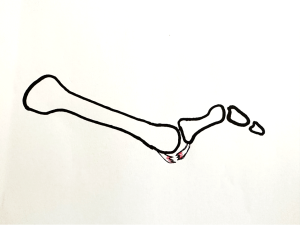Anatomy
The joint capsule under the metatarsophalangeal joint (MPT) is reinforced by a fibrocartilaginous (connective tissue/cartilage) connective tissue plate (called plantar plate or volar plate) that helps stabilise the joint.
Cause
Repeated stresses (e.g. running with braking and changing direction) or if the toe is bent backwards strongly (hyperdorsiflexion), the plantar plate is overloaded and can end up rupturing, making the metatarsal joint unstable.
There is often swelling (oedema) under the toe. Scar tissue formation (pericapsular fibrosis) is very common in the joint capsule with injuries to the plantar plate (Mann TS, Et Al. 2022). The injury is commonly seen on synthetic pitches (hence the name Turf-toe). Damage to the plantar plate is a common and often overlooked injury.
Symptoms
Acute or, more often, slow onset pain under the big toe with worsening on exertion. Many have had pain for several months before seeking help (Mann TS, Et Al. 2022). The pain can progress to the point of being athletically debilitating.
Examination
Diagnosis is made by clinical examination by the relevant professional. There is pain on pressure under the metatarsophalangeal joint of the big toe with worsening when the toe bends upwards (extends). Imaging (X-ray, ultrasound or MRI scan) is often necessary to support the diagnosis. Ultrasound and MRI scans can determine if the plantar plate has ruptured. If the plantar plate ruptures, the sesamoid bones will often retract (proximally) in relation to the opposite foot, as seen on ultrasound or X-ray.
Treatment
Treatment includes primary relief from pain-inducing activity with slowly increasing load within the pain threshold. It is recommended that shoes with stiff soles are used, possibly with a hinged sole. Splinting and taping can be tried.
In cases of inflammation in and around the plantar plate with a lack of progress on unloading, you can try to supplement with medical treatment in the form of arthritis pills (NSAIDs) or ultrasound-guided injection of adrenal cortex hormone corresponding to the inflamed area, although the evidence is modest.
In complex cases with plantar plate rupture or persistent discomfort despite relief and medical treatment, surgery may be indicated, but surgery is only performed in about 2% (Najefi AA. Et al. 2018 ).
Rehabilitation, specific
Loading within the pain limit is allowed. Guidelines during rehabilitation are generally followed. Fitness can be maintained by cycling and swimming.
Complications
However, if the progression is not smooth, you should consider whether the diagnosis is correct or if there are complications:
Rheumatic disease of the large toe joint (e.g. osteoarthritis, gout),
Sesamoid bone pain under the big toe
Bone fractures
Stiffness of the big toe (hallux rigidus)
Tendonitis
